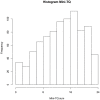Measuring the Moment-to-Moment Variability of Tinnitus: The TrackYourTinnitus Smart Phone App
- PMID: 28018210
- PMCID: PMC5156957
- DOI: 10.3389/fnagi.2016.00294
Measuring the Moment-to-Moment Variability of Tinnitus: The TrackYourTinnitus Smart Phone App
Abstract
Tinnitus, the phantom perception of sound without a corresponding external sound, is a frequent disorder which causes significant morbidity. So far there is no treatment available that reliably reduces the tinnitus perception. The research is hampered by the large heterogeneity of tinnitus and the fact that the tinnitus perception fluctuates over time. It is therefore necessary to develop tools for measuring fluctuations of tinnitus perception over time and for analyzing data on single subject basis. However, this type of longitudinal measurement is difficult to perform using the traditional research methods such as paper-and-pencil questionnaires or clinical interviews. Ecological momentary assessment (EMA) represents a research concept that allows the assessment of subjective measurements under real-life conditions using portable electronic devices and thereby enables the researcher to collect longitudinal data under real-life conditions and high cost efficiency. Here we present a new method for recording the longitudinal development of tinnitus perception using a modern smartphone application available for iOS and Android devices with no costs for the users. The TrackYourTinnitus (TYT) app is available and maintained since April 2014. A number of 857 volunteers with an average age of 44.1 years participated in the data collection between April 2014 and February 2016. The mean tinnitus distress at the initial measurement was rated on average 13.9 points on the Mini-Tinnitus Questionnaire (Mini-TQ; max. 24 points). Importantly, we could demonstrate that the regular use of the TYT app has no significant negative influence on the perception of the tinnitus loudness nor on the tinnitus distress. The TYT app can therefore be proposed as a safe instrument for the longitudinal assessment of tinnitus perception in the everyday life of the patient.
Keywords: chronic tinnitus; crowd sourcing; ecological momentary assessment; ecological validity; moment-to-moment analysis; smartphone application.
Figures




References
-
- Csikszentmihalyi M., Larson R. (2014). “Validity and reliability of the experience-sampling method,” in Flow and the Foundations of Positive Psychology, ed. Csikszentmihalyi M. (Berlin: Springer Netherlands; ), 35–54.
LinkOut - more resources
Full Text Sources
Other Literature Sources
Research Materials
Miscellaneous

